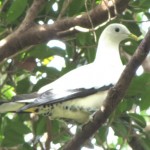PIPs/TIPs live in tropical Queensland from early Spring until late Autumn and form large roosting and breeding colonies on some of Queensland’s many offshore islands. Some birds roost intermittently in small groups on the mainland coast and a few birds nest at scattered locations on the mainland coast of Queensland.
These birds have a vital ecological role in dispersing the seeds of Queensland’s tropical rainforest trees. PIPs/TIPs eat the whole fruit of many different rainforest trees, including fruits too large for other birds to swallow.
Excreted seeds get dispersed widely because these birds are strong fliers and range over a wide area as they search for native tree fruits at the right stage of ripeness. Seeds in PIP/TIP droppings are ready to sprout and grow into new rainforest trees that will benefit future generations of birds and many other species including humans.
During the day PIPs/TIPs can be spotted in many coastal areas of Queensland as they fly out early in the morning to search for food and return to their nesting and roosting sites in the late afternoon. Individuals and small groups may also be spotted in parks and gardens where they sometimes find native trees with ripe fruit.
When a pair of PIPs/TIPs is ready to breed, the male and female birds build their nest together. Then one partner stays, in order to attend the nest continuously. The other partner goes off to forage for the whole day. They swap duties the next day. This pattern continues while they incubate their single egg and raise their chick.
The parent birds have a tremendous workload. They need to find enough food (native tree fruits) each day to maintain their own strength for flying great distances, and at the same time need to bring back enough food for their growing chick.
Large chicks start to scramble around their nest tree and make short flights close by. However, they remain near the nest until they are fully grown. They need to be strong enough for their first non-stop long flight over the sea to the mainland.
Almost all PIPs/TIPS leave Queensland for a short winter break when they migrate to Papua New Guinea. A few stragglers remain behind in some years. After a few months absence, the travelling flocks return to Queensland in late August and early September and start the next breeding season.
Read more here if you are interested in helping with research and conservation in Queensland.
If you see PIPs/TIPS outside Queensland, please read here.
